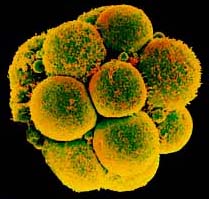While stem cell research itself is a relatively new field,
the historical foundations for it go back over a century.
- 1878 - First recorded attempts to fertilize mammalian eggs outside
of the body
- 1959 - Rabbits are produced as the first successful use of in vitro
fertilization
- 1968 - Human embryos are created artificially, using in vitro fertilization
- 1978 - The first human baby created through in vitro fertilization
is born
- 1981 - Stem cells are extracted from mouse embryos, and are discovered
to be pluripotent
- 1998 - James Thomson at the University of Wisconsin-Madison derives
human embryonic stem cells from a fertilized human embryo. These cells
are proven to be pluripotent, and develop into the first line of human
embryonic stem cells.
- 2000 - Thomson's discovery is confirmed through the work of other
scientists around the globe, many of whom established their own stem
cell lines.
- 2001 - President George Bush chooses to partially fund investigation
into stem cell research. Scientists at Advanced Cell Technology Laboratories
are able to clone human embryos, but they cease to divide after four
or five generations of cells are created.
- 2002 - Stem cell research continues to be pursued, as more people
recognize the importance of the technology these cells embody.
|

